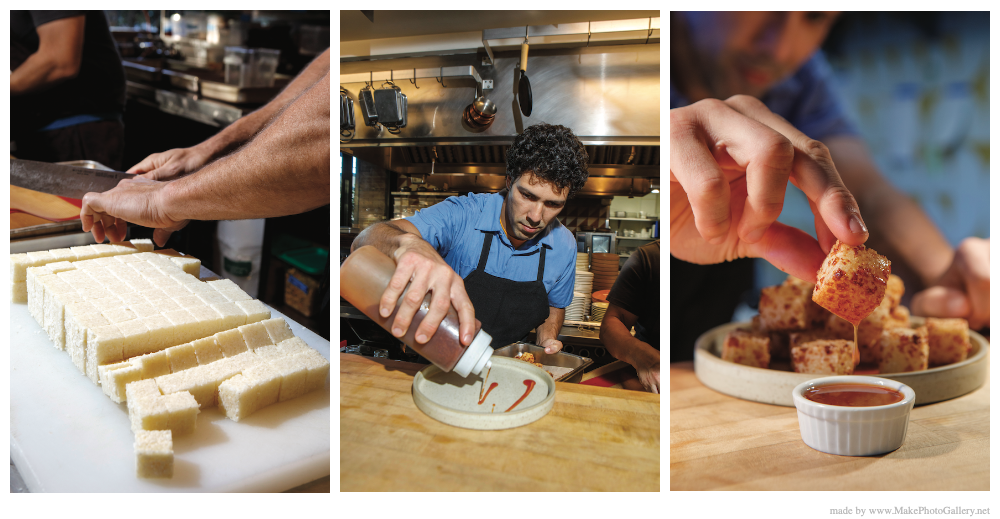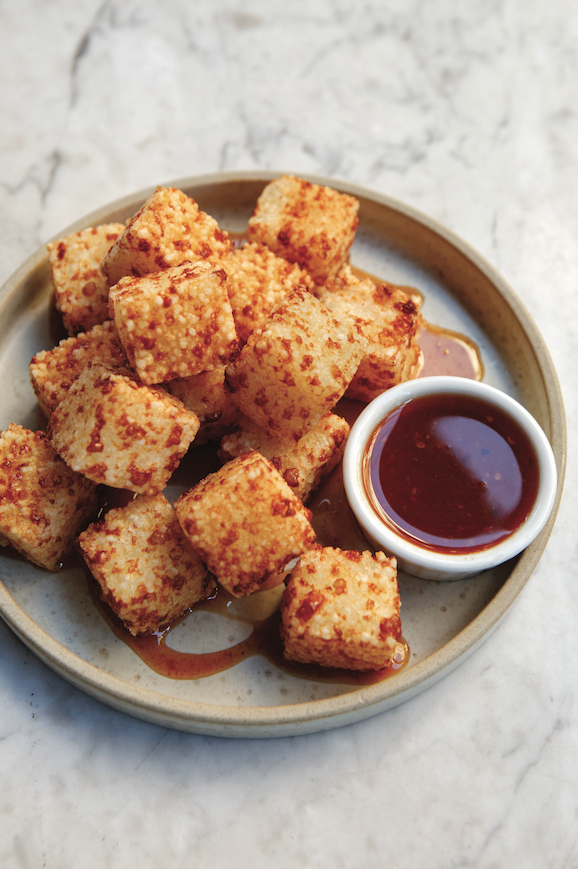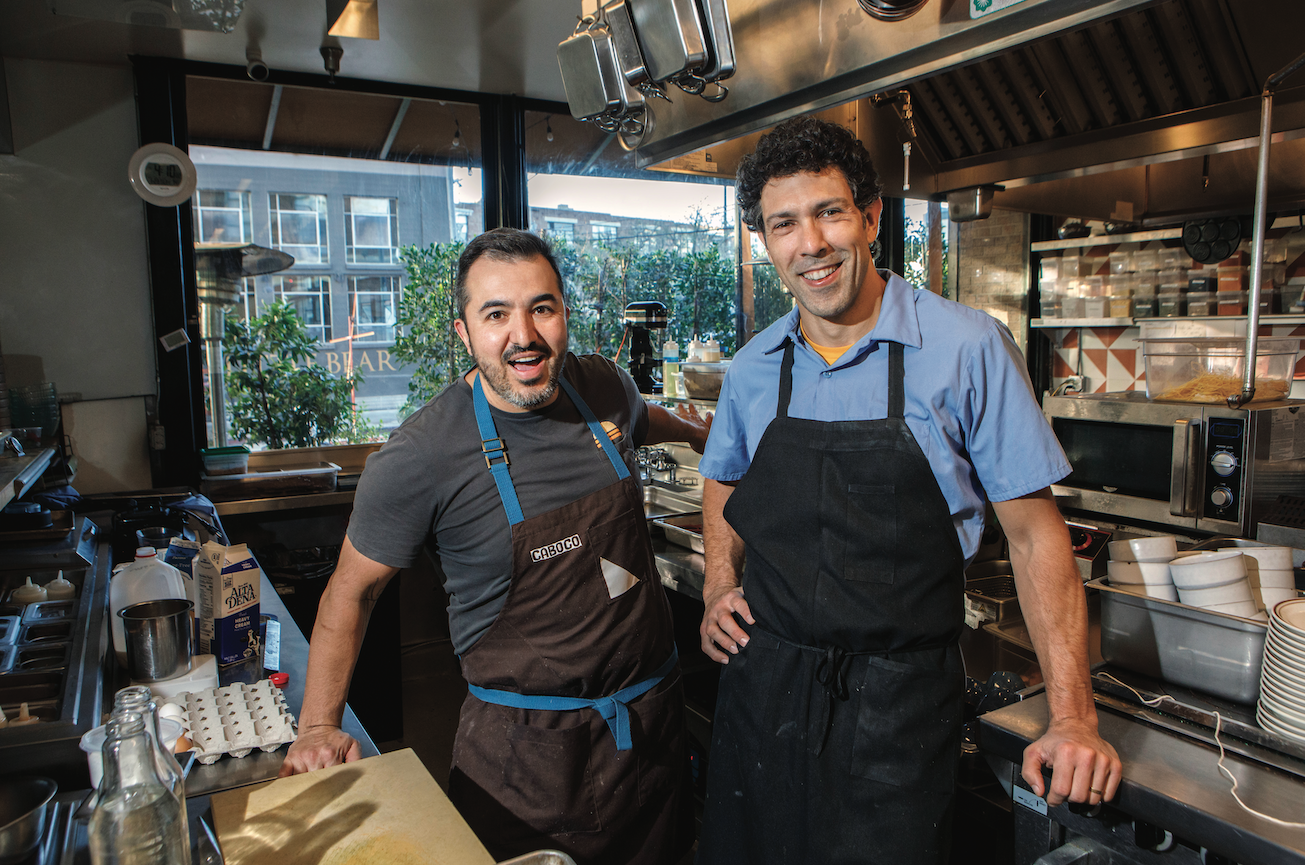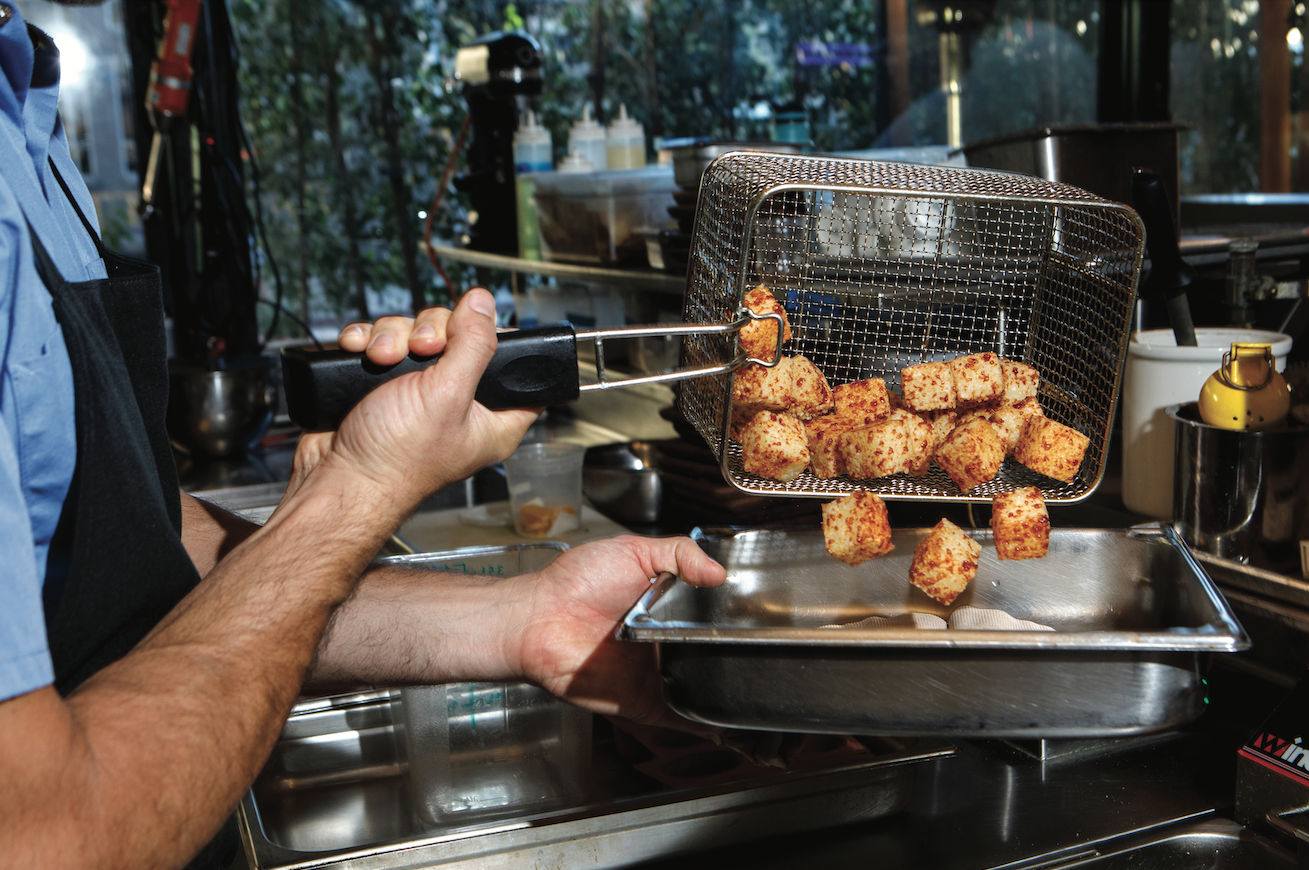Victor Vasconcellos (left) and Rodrigo Olivera
What do people beyond Brazil’s borders know of its cuisine? The answer is probably very little, unless perhaps they’re thinking of juicy steaks or frozen açaí berries. Brazilian chef Rodrigo Oliveira is on a mission to change that with Caboco, the Los Angeles restaurant he opened late last year with fellow chef Victor Vasconcellos and veteran restaurateur Bill Chait as business partners.
Caboco has the distinction of being the first modern Brazilian restaurant to open in the US. Despite earning a Michelin star, Bib Gourmand Awards, and a regular slot on San Pellegrino’s Latin America’s 50 Best Restaurants list for his São Paulo restaurants, Oliveira has resisted international expansion until now. This new venture, in LA’s downtown Arts District, infuses Brazilian DNA into a bounty of Californian ingredients. “Caboco is Brazil in California, because it’s impossible to contextualize a restaurant without creating a real relationship with its surroundings,” says Oliveira. “It’s Brazilian cuisine but with a Californian accent, especially in the produce.” Fish, shellfish, meat, fruit, and vegetables are all local, as are beans—a mainstay of Brazilian cooking—which are sourced from Rancho Gordo, a nearby farm specializing in heirloom varieties. Oliveira and Vasconcellos bring certain types of cassava flour over in their suitcases and import Brazilian chili peppers, amburana, cumaru (tonka beans), and puxuri—beans with names that are as interesting as the flavors they impart.
Cheese is also on the menu and, like Caboco itself, is a mix of Brazil and California. The chefs use Brazilian queijo coalho (curd cheese) in baião de dois, a traditional dish of rice, beans, and cheese (or cream) served with salt-cured meat. The dadinhos de tapioca (crunchy cubes of cheesy tapioca, see recipe) are made with a mix of queijo coalho and locally made queso panela. Oliveira also serves pastéis—pastries with savory fillings that are a classic street food in Brazil, fried in huge vats of oil at farmers markets. “We said, ‘Wow, there are so many good cheeses here, we should do a cheese pastel,’” he says. “We fell in love with a California sheep’s cheese—Lamb Chopper from Cypress Grove—and use that to fill the pastel.” Four years in the making, Caboco was an almost instant success when it finally opened, landing on Los Angeles Magazine’s list of the best new restaurants for 2022, and Thrillist LA’s list of best dishes in 2021 for the dadinhos detapioca. “We opened without much fanfare, discreetly, because it’s difficult to manage a full house in the first few days. But the Brazilian community showed up in full force,” says Oliveira. “I never imagined there were so many Brazilians in California. They came back with their American friends, and then the rest of the world showed up when journalists started to write about it.”
In São Paulo, Oliveira runs a small food empire. Mocotó—a restaurant established by his father in 1973—serves dishes from the sertão, a poor, scrubby hinterland region in Brazil’s northeast, where Oliveira’s family comes from. A pared down version of this menu is served at Mocotó Café and a Mocotó food truck. Balaio IMS is Oliveira’s more upscale restaurant, in a wealthy part of town with a menu that nods to other regional Brazilian cuisines. Mocotó is the crown jewel, although it’s located in a working-class northern suburb well off the city’s gourmet circuit. It’s something of a pilgrimage for paulistanos on weekends, when lunch takes the better part of a day. A long wait for a table (the restaurant doesn’t take reservations) is part of the ritual, but it flies by thanks to a succession of tropical fruit caipirinhas and plates of torresmo (pork cracklings) and tapioca cubes.
 Making dadinhos de tapioca (cheesy tapioca cubes)
Making dadinhos de tapioca (cheesy tapioca cubes)
“The tapioca cubes were an instant hit when I put them on the menu at Mocotó 15 years ago” says Oliveira. Their success has far outgrown Mocotó, copied by copious bars and restaurants and made in households all over the country; supermarkets even sell a ready-made version. “I’d love to own the copyright,” he says with a good-natured laugh, but what he loves more is knowing that so many people enjoy his invention.
In Brazil, the tapioca cubes are made with queijo coalho, a mild and salty cow’s milk curd cheese found across the country in its industrial form, on wooden skewers. It’s grilled at barbecues and even sold as a beach snack in Rio de Janeiro, browned on tiny coal grills that are hauled up and down the shoreline by vendors.
In São Paulo, Oliveira sources queijo coalho for his restaurants from Fazenda Atalaia, an artisanal cheesemaker in the interior of the state, but says that the cheese traditionally originated in Brazil’s northeast region. “Our farm in Pernambuco is in the middle of the sertão. Our family made cheese. It was an important milk-producing region and where milk was produced, so was cheese.” Today, many of the region’s farmers sell their milk to cooperatives for industrial production, but some still make the cheese in the traditional way. “Cheese is still really important both culturally and economically there,” says Oliveira.
While some Brazilian cheesemaking traditions have lost out to larger scale operations, others have blossomed over the past decade. Star chefs in São Paulo like Oliveira were a catalyst for this cheese revolution, which began in 2012 when they first discovered Canastra cheese and began using it on their menus. The raw cow’s milk cheese, which has a sharp and full-bodied flavor, earned a geographical indication status that year—the first Brazilian cheese to do so—giving a seal of authenticity to cheeses made in the traditional way in the Serra da Canastra highland region of Minas Gerais state.
“Chefs gave regional cheeses a visibility that in turn created a market for small producers to sell their cheeses further afield,” explains Flávia Rogoski, a director of SerTãoBras, an association that promotes artisanal cheesemakers in Brazil. “Nowadays, artisanal cheeses are in demand in Brazil, and it’s exciting to see the quality and the creativity of the producers getting better all the time.”
Last year, Brazilian cheesemakers were earning prestige abroad as they placed second only to France in the number of medals scooped up at the Mondial du Fromage in Tours. At the same time, Oliveira was starting to share the nuances of Brazilian cuisine with a new, international audience at Caboco. “I see myself as an unelected ambassador for Brazilian cuisine,” he says. “It’s so diverse. Brazil is continental, with different landscapes, an intersection of cultures and an infinity of cuisines. We now also have a crop of chefs with the know-how to open restaurants in any capital of the world. If there was ever a good moment to do this, it’s now.”

Dadinhos de Tapioca (Cheesy Tapioca Cubes)
Ingredients
- 10 ½ ounces queijo coalho and/or queso panela
- 1 cup plus 1 tablespoon granulated tapioca
- 1 ¾ teaspoon salt less if the cheese is very salty
- Pinch white pepper
- 2 cups whole milk
- Neutral oil for deep frying
- Sweet chili jam or molasses for dipping
Instructions
- Cover a sheet pan with cling wrap.
- Grate cheese finely (a food processor with the shredding blade is ideal for this) and mix with granulated tapioca, salt, and pepper. Combine well.
- Bring milk to a boil, then add to the tapioca mixture. Stir until mixture starts to firm up and tapioca absorbs the milk.
- Pour mixture evenly onto the tray and cover with cling wrap. Leave to cool and refrigerate for at least 3 hours (or up to 3 days).
- Cut into cubes (roughly 1 inch) and deep fry in hot oil until golden. They should be crispy and dry on the outside and soft inside.
- Serve with sweet chili jam or molasses for dipping








